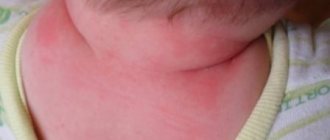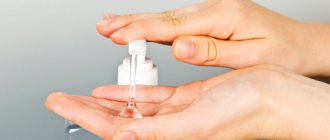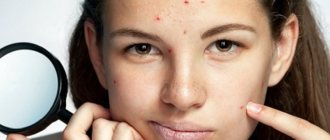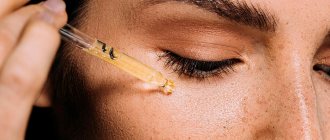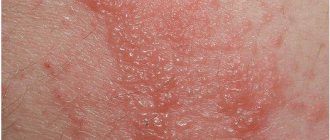Features of the appearance of white spots
According to dermatologists, there are several diseases that are caused solely by skin problems. All other phenomena are just symptoms of malfunctions in the internal functioning of the body. A change in pigmentation should alert a person and force him to see a specialist.
Photos on the Internet show that the location of the spots, their shade, size and shape are unique in each case. The causes of a color defect are determined by all these factors; they can be infectious, hereditary, autoimmune, or traumatic. They are united under a single term - leucoderma, which means a disorder of pigmentation of the skin.
| Type of leucoderma | Signs | Provoking factors |
| Hereditary - albinism. | Light skin tone, eye color, hair color due to a small number of cells that produce melanin. | Prolonged exposure to the sun is contraindicated; sunbathing in a solarium is prohibited to prevent sunburn. There is no cure for albinism. |
| Autoimmune - vitiligo. | Light spots have uneven edges, a tendency to increase in size and merge with each other into a large depigmented area. The spots do not itch, do not flake, and are not transmitted to others by contact. | Malfunctions of the digestive tract, stress, endocrine disorders. |
| Infectious - white, multi-colored/pityriasis versicolor. | Fungal pathogens provoke the appearance of flaky round spots with uneven edges in the scalp, face, neck, armpits, and back. The color ranges from milky to brown depending on the time spent in the sun. The spots may itch, but sometimes the disease is asymptomatic and disappears on its own, entering a stage of long-term remission. | Contact with a sick person, use of other people's bedding or hygiene items. Wet sand is a good environment for the proliferation of fungi and viruses, including fungal diseases of the skin and nails. |
| Traumatic - scar tissue after chemical, sunburn, deep skin damage. | In injured areas of the dermis, after the wound has healed, the pigment melanin may be absent. This may be due to the lack of contact of the new skin with ultraviolet radiation due to scabs above it. With the growth of connective tissue that does not contain melanocytes (cells that produce melanin). | Appears after damage to the skin for the specified reasons. |
| Systemic - diseases of internal organs, metabolic disorders (psoriasis). | Spots localized on the arms and legs, in places where the skin tends to become rough. They have different shades: from light milky to dark pink, have a tendency to peel, and are covered with scales. | Excess weight, stress, bad habits, unfavorable living and working conditions. |
| Allergic – medicinal or contact. | The development of allergies is accompanied by depigmentation in places where the skin is most sensitive: the stomach, the inner surface of the arms and legs. The spots may peel and grow in number. | The appearance of light spots is caused by taking certain medications. You can get rid of it by stopping the allergen drug. |
| Professional. | White spots and dots on the body occur as a result of professional work with certain chemicals, if you work without taking precautions. | Contact with the skin or accumulation of harmful substances in the body can discolor it. |
Light spots on sensitive skin may be a type of non-pigmented or anemic nevus, that is, a mole that is not brown in color. Such a spot should be examined by a doctor; a biopsy will determine the need to remove such formations. The area of the body with nevi should be protected from solar radiation and any injury.
A baby under the age of 2 months may develop hypomelanosis, which is the reason for an emergency visit to the pediatrician. You can treat this phenomenon at home; in most cases, symptoms go away over time under the supervision of a doctor.
Diagnosis when spots appear
Urticaria from a food allergen, which appears suddenly, also disappears instantly after it is removed from the body. It has characteristic signs and is easily diagnosed.
Clinical manifestations of dermatitis are confirmed by laboratory tests of blood and skin tests. In this case, an increased number of leukocytes (eosinophils) is detected and the concentration of immunoglobulins is determined. Skin tests make it possible to determine the substance that caused the allergy.
The affected area of the skin is lubricated with an iodine solution or brilliant green (in areas affected by the fungus, the coloring of the skin is more intense due to the loose epidermis);
Scraping is done in places where the skin peels (microscopic examination allows you to detect fungus in the epidermis);
Luminescent examination reveals red-yellow or dark brown fluorescence.
Change in nipple shape (retraction or deviation);
Redness and swelling;
Discharge from the nipple;
Swelling of the hand;
The presence of compaction in the tissues.
The next stage is a comprehensive examination to identify the location and size of the tumor and the degree of metastasis.
Lymphatic system;
Abdominal organs;
Spine.
An insect bite is a small wound that becomes inflamed by the saliva of mosquitoes, gadflies and horseflies that get under the skin. Scratching causes the skin irritation to increase in size, which can make diagnosis difficult. Bites are rare and require only observation.
Pigment defects can be eliminated using cosmetics or cosmetic procedures. The choice of technique depends on the level of melanin production and the severity of neoplasms.
To eliminate hyperpigmentation, cosmetics based on retinoids, derivatives of vitamin A, are used. Manufacturers add such substances to lightening creams and serums.
The products must contain vitamins C, E, B5. It would be great if the cream contains a mark on the packaging - SPF 30. This means that the cream (lotion or other) protects the epidermis from the harmful effects of ultraviolet rays.
Pigment spots under the breasts or on the mammary gland are eliminated with special cosmetic procedures, including:
- superficial peeling using fruit acids with different concentrations: a low-traumatic and painless manipulation, which additionally eliminates the dead layer of the dermis;
- deep peeling, which is carried out with trichloroacetic or salicylic acid: it is more traumatic than superficial peeling, helps smooth out wrinkles and improve the color shade of the dermis;
- laser cleaning: causes the destruction of pigmented tumors, is considered a painless and low-traumatic procedure;
- photo-removal: eliminates pigmentation without causing skin damage, absolutely painless manipulation;
- the use of liquid nitrogen - cryotherapy: it is traumatic, reddened areas remain after the procedure.
Folk remedies
Pigmentation is treated with folk remedies. The following have a whitening effect:
- lemon and sour cream: grate half the lemon zest, add an equal volume of sour cream, apply the resulting product to the defects, leave for half an hour, rinse with warm water (make a mask 2 times a day);
- lemon juice: apply lemon juice to the pigmented areas several times a day until they disappear;
- hydrogen peroxide: moisten a piece of gauze in the product, make a compress on pigmented tumors, leave for 20 minutes (do the procedure every day);
- hydrogen peroxide and cottage cheese: mix 100 g of low-fat cottage cheese with 2 tbsp. peroxide, apply the resulting product to the tumor, securing it with a napkin on top, leave for half an hour (do the procedure daily);
- parsley: chop the leaves, pour vodka in a ratio of 3 tbsp. greens per 100 g of liquid, leave for a week, lubricate the stains with the prepared infusion every day;
Excellent for treating curdled milk hyperpigmentation. Using this, compresses are made by moistening a piece of gauze in it and applying it to the affected areas daily.
Conclusion
To prevent increased melanin production, constant replenishment of vitamins and beneficial microelements in the body and the use of high-quality cosmetics are required. It is important to get rid of diseases that cause hyperpigmentation.
If you were unable to avoid the appearance of such tumors, there is no need to despair. Cosmetology has many techniques that can quickly get rid of such a defect.
The problem of skin pigmentation into darker colors is very common as their variety is very wide. Most stains do not pose a threat to health, but they spoil the appearance and affect self-esteem. But some may indicate serious illnesses, including melanoma (a form of skin cancer).
In medical practice, there have been situations when people ignored the first symptoms (in the form of red or brown spots) for the following diseases:
- scarlet fever;
- chickenpox;
- prickly heat;
- syphilis;
- allergic dermatitis.
Most of the diseases that are accompanied by skin rashes in the chest area are dangerous to human health.
In the chest area is the mammary gland. Any slight impact in its area indicates the presence of diseases associated with:
- work of the gastrointestinal tract;
- liver diseases;
- vitamin deficiency;
- skin reaction to light rays;
- taking hormonal medications;
- taking certain contraceptives;
- problems with the thyroid gland;
- renal failure;
- injury to the skin.
The most reliable way is to consult a doctor if you notice symptoms. In some cases, you can use self-diagnosis.
Self-diagnosis
When the first symptoms appear, if they are painless, you can carry out a number of procedures that will help determine the disease.
Sample instructions:
- Check for any hard lumps in the chest area.
- Palpate the breasts and if any deviations are noticed (changes in the shape of the nipples, the nipples become more retracted or swollen), then inform the doctor.
- Special attention should be paid to the color of the chest. If it remains the same, then everything is fine.
- It is worth checking the armpit area as well. This should be done with gentle circular movements.
- If necessary (if there is any pain), you need to move your arms, wait until the pain is felt and observe the chest in this position for some time.
If during self-diagnosis any violations were noticed, then clinical diagnostics should be used.
The most acceptable solution is to sign up for a session with a dermatologist; if the cause of the skin disease is a problem with the internal organs, then be additionally examined by a surgeon and mammologist. In this case, it will be necessary to conduct an ultrasound to make sure there are no serious diseases.
These balls are quite dense to the touch; when pressed on them, a white liquid, odorless and viscous in structure, can be released. Mostly women do not feel pain symptoms. But in the bathroom, some women may feel discomfort in their breasts, because during steaming these formations become dense.
White dots on the nipples most often appear in nursing mothers and young girls whose mammary glands are actively maturing.
Many women who carefully monitor their breasts and perform regular breast palpation can immediately detect changes. Due to improper functioning of the mammary glands, small white dots may form on the nipples.
Canal blockage can be caused by insufficient or ineffective hygiene procedures. Therefore, you should take a shower every day, after which you should wipe your chest with a rough linen towel, despite the discomfort.
In young girls, the appearance of white spots provokes the production of adipose tissue in large volumes.
Many nursing mothers face the same problem. But the reason for the formation of white spots is not the large production of adipose tissue, but the way the baby takes the nipple.
If a child grabs the nipple in only one place, then after a certain time a small hematoma may appear there, on which white dots will be located. In this case, the milk ducts become clogged with fat from accumulated milk, which does not leave during feeding.
Over time, the newly formed balls begin to itch, bringing discomfort and sometimes pain to the woman.
Every nursing mother should know these rules:
- The nipple is the most sensitive part of the breast, so you should give your baby the breast from different sides to avoid pain as much as possible.
- Remember that the ducts must be open. In another case, you may develop mastitis, which is treated at the clinic.
- If the white dots on the nipples are present in small quantities, they can be removed by pressing. The nipple must first be treated. This way, you can pull out the entire plug, behind which milk may begin to come out.
- Under no circumstances should you pierce yourself. Consult a doctor!
- If you periodically experience white spots on your chest, then you need to contact a gynecologist or mammologist. Most often, in such cases, medication and accompanying physical procedures are indicated.
- Remember that pellets can also be a symptom of thrush, which can be passed from mother to baby and vice versa. Be sure to keep your mammary glands clean. The cause of thrush is Candida fungi.
Thrush can cause cracks, maceration, or other damage to the nipple during feeding. Candidiasis mainly affects the areolas of the mammary gland and, accordingly, the oral cavity of the baby. If the doctor has confirmed that the female nipples are affected by thrush, then it is necessary to treat not only the mother, but also the child.
Probable causes of appearance
Treatment of the disease begins with identifying the causes of its development. Inhibition of melanocytes or their destruction in certain areas of the body is associated with external and internal reasons. The occurrence factors may be infected or non-infected. Among the former, the leading position is occupied by white or multi-colored/pityriasis versicolor. It is not enough to have fungus on the skin; if the immune system is functioning normally, its quantity will remain at a level that is not capable of triggering the onset of depigmentation. And only under the influence of factors such as stress, pregnancy, childbirth, warm climate, diet, diet with a predominance of sweet and carbohydrate foods, lack of vitamins, the infection will manifest itself, as a result of which spots without pigment will appear on the body.
Non-infected factors for the appearance of pale spots on the skin can be called autoimmune diseases. Vitiligo affects people of all ages and both sexes; the disease is characterized by suppression of the function of pigment production in cells by the immune system. For reasons unknown to science, its own defense system views melanocytes as hostile organisms and inhibits them, as a result of which their work is disrupted; they cannot produce the pigment responsible for the normal shade of the dermis. It is believed that people with a genetic predisposition to skin diseases and problems with the digestive system are prone to vitiligo.
The same problems with the digestive tract can cause certain diseases (psoriasis or eczema). Medical science cannot name the exact reason for their appearance. It is believed that excessive skin renewal in certain areas of the body, accompanied by peeling, depigmentation, and the appearance of scaly horny growths, is associated with disruptions in the hormonal, immune, and digestive systems. Some dermatologists cite the reason for the appearance of light spots in skin diseases as the lack of solar radiation, which is necessary for the production of melanin.
Treatment methods
Dermatologists, gastroenterologists, nutritionists, allergists, and cosmetologists deal with skin problems. Making a specific diagnosis requires a specific treatment protocol. Small spots and dots from vitiligo are easier to disguise with permanent makeup from a cosmetologist. If there is a tendency for the disease to spread, the patient is prescribed immunosuppressive drugs containing hormonal components. They suppress local immunity, allowing cells to produce melanin. Another series of medications enhances the work of melanocytes, accelerating cell metabolism, nourishing and moisturizing them. Before using local preparations to disinfect the skin, treating it with hydrogen peroxide is justified.
Systemic diseases of internal organs and problems in the digestive tract are treated by dermatologists and gastroenterologists. Local treatment in the form of ointments and creams relieves symptoms, and internal preparations correct the functions of organs involved in processing and assimilation of food. Medicines for the liver, pancreas, enzymes, sorbents, etc. are prescribed by the doctor, and the patient is prescribed a diet.
Antifungal therapy is prescribed to patients with lichen. Such patients are prone to increased sweating, which is a reason to visit a cosmetologist. If the cause lies in an unhealthy lifestyle and diseases of the internal organs, the gastroenterologist will select drugs to restore their functions.
You can cure depigmented spots at home under the supervision of a doctor, whose recommendations are mandatory. You shouldn’t immediately run to the pharmacy, hoping for a quick relief from your ailments, after reading a lot of reviews on the Internet. Only a doctor will collect anamnesis, tests, make a diagnosis and prescribe adequate treatment.
Is it possible to get rid of Montgomery's tubercles?
During the normal course of pregnancy and breastfeeding, Montgomery's tubercles will disappear on their own over time.
More precisely, they will return to their previous state in which you did not pay attention to them before. If something goes wrong and the tubercles do not decrease or become inflamed, consult a doctor. He may prescribe anti-inflammatory or bactericidal medications for local treatment.
In extreme cases, modern medicine offers plastic surgery services. And although such operations are possible, it is still worth thinking about their necessity.
Contrary to the widespread and sometimes erroneous opinion that there are no more mysteries left for scientific researchers in the human body and organism, the exact nature of the Montgomery glands is still not known - this is the name given to the tubercles on the mammary glands near the nipples. Experts and doctors are still arguing about the nature of their specific activity, since the latter cannot classify them as either sweat or sebaceous glands.
The only thing that has been determined is their critical role that they play during breastfeeding of newborns. Let's take a closer look at the mysterious pimples around the halo and try to determine their true biological role for the female body.
What these tubercles are is one of the mysterious parts of the human body.
Montgomery's glands are located on the areola, a pigmented area of skin near the nipple. They are ducts of secretory glands located under the skin. They were first described back in the nineteenth century, but their nature has not been fully elucidated.
These pimples begin to develop after puberty, usually along with breast growth, and their development peaks during the last trimester of pregnancy and lactation. To the touch they are very similar to small balls located in the skin layers. Their heyday comes during pregnancy and breastfeeding, and then their regression gradually begins.
The number of Montgomery glands on a woman's breast ranges from four to twenty-four.
How to Avoid Light Spots
Prevention is an important part of treating any disease. In order not to complicate your life with visits to the doctor due to light spots on the skin, it is recommended:
- if you are predisposed to vitiligo, avoid stress;
- relax more often, spend time in nature;
- give up bad habits or at least reduce the amount of cigarettes and alcohol;
- eat in small portions, which will facilitate the functioning of the digestive system;
- switch to a healthy diet;
- treat the child with medication only from a doctor;
- use traditional medicine only as an aid;
- use protective equipment when working with chemicals;
- take medications only as prescribed by a doctor;
- use creams and ointments to prevent the formation of scars, scars from injuries, cuts and acne;
- remove allergy-provoking factors;
- lose excess weight.
Removing stains from skin is sometimes a difficult task. By following these recommendations, a person will be able to prevent the occurrence of defects, qualitatively improve his life, and a dark, healthy dermis will delight the reflection in the mirror.
It happens that white spots begin to appear on the skin due to various reasons. Most often, doctors diagnose vitiligo, which is a disorder of skin pigmentation. This disease is not life-threatening, but it is very difficult to treat. It can occur in both adults and children.
In any case, the appearance of white spots on the body, in addition to a cosmetic defect, may indicate that there are some problems in the functioning of internal organs .
Therefore, you should not postpone a visit to a dermatologist, who, based on the examination of the patient and his examination, will help you choose the right treatment.
What are Montgomery tubercles?
Montgomery tubercles or Montgomery glands are small “pimples” located on the chest around the nipple - in the area of the so-called areola.
There can be a different number of these tubercles - from a few pieces to a dozen or more. These tubercles received their name from the name of the doctor who first began to study them, William Montgomery.
Many experts believe that the Montgomery tubercles are vestigial glands. They were prompted to this conclusion by the fact that these formations begin to appear during puberty, and their growth is activated during pregnancy, when the woman’s body prepares for lactation.
But the true purpose of Montgomery's glands has not been established.
What is vitiligo
This disease is considered the most common cause of spots on the body that have a round or oval shape. In such areas, due to various reasons, the pigment melanin ceases to be produced, as a result of which the skin becomes defenseless against exposure to sunlight and burns often occur in this area.
The causes of vitiligo are the following factors:
- severe viral diseases leading to decreased immunity;
- heredity;
- disruption of the hypothalamus and pituitary gland, resulting in an imbalance of hormones in the body;
- parasitic intoxication;
- autoimmune diseases;
- work related to such harmful substances as phenol, formaldehyde, synthetic resins, heavy metals;
- mental and physical fatigue, as well as stress.
Milky white or pink areas can appear anywhere, but most often they form on the hands, face, elbows, and groin. They are especially noticeable in people with dark skin. This discoloration is not observed on the palms and soles If age spots appear in a specific area of the body, then in this case the disease is localized.
At the most severe stage of the disease, the skin becomes completely discolored, like an albino. The sensitivity of the skin remains the same, pain does not occur. If white spots form on the head, then the hair in this place loses its color. Sometimes in such areas, sebum and sweating are disrupted, the skin loses its sensitivity, and solar dermatitis occurs.
This disease affects 1–2% of people ; it most often develops in young people; older people do not suffer from it. Vitiligo affects both men and women equally. In some cases, it accompanies skin diseases such as focal baldness, lichen planus or psoriasis.
Treatment of vitiligo
You need to know that it is possible to completely cure such a pathology if concomitant diseases can be eliminated. Treatment can be complex and include one or another therapy.
To achieve success, the doctor may prescribe a drug such as Melagenin Plus, consisting of calcium chloride and an alcoholic extract of the human placenta . Improvement should occur after a week of treatment, and significant progress should be expected only after six months. The drug is applied externally to problem areas, do not rub in, but wait for it to be absorbed.
Other causes of white spots
Pityriasis versicolor
Thanks to modern research, it has been found that the most common cause of such spots is pityriasis versicolor. It is a chronic infectious skin disease of fungal origin .
Most often, lichen affects the shoulders and back and is initially brownish or red in color, then peels off and turns white. It is not transmitted through person-to-person contact. The disease mainly spreads in people who live in humid and warm conditions. Factors such as oily skin, pregnancy, weakened immunity, excessive sweating, nutritional deficiencies, and corticosteroid use also contribute to the appearance of pathology.
Pityriasis versicolor should be diagnosed and treated by a dermatologist. After clarifying the diagnosis, he must prescribe comprehensive measures to cure it. These should be antifungal drugs such as:
- terbinafine;
- miconazole;
- clotrimazole;
- nizoral;
- itraconazole;
- fluconalosis and others.
Shampoo containing selenium sulfide should be applied to the affected areas. This must be done before going to bed, and in the morning it is washed off. If symptoms do not go away within two weeks, you should seek advice from a dermatologist.
Idiopathic guttate hypomelanosis
This disease is characterized by the fact that small white spots , most often appearing on the arms, legs, shoulders, and face. Mostly these spots are smooth, but sometimes they begin to peel off. This skin disorder is common in women and people with fair skin.
The exact reasons for the appearance of light spots are unknown. However, many experts believe that idiopathic guttate hypomelanosis occurs as a result of the natural aging process, as it is mainly diagnosed in people over 40 years of age. In addition, the reason may lie in heredity, because the disease is often observed in blood relatives.
To cure this disease, ointments with tretinoin and corticosteroids , microdermabrasion, dermabrasion, and cryotherapy are used.
Pitiriaz
With this disease, white or pale pink spots begin to appear on the skin of the face, neck and arms. Skin disorders are especially noticeable in the summer, when normal areas of the skin tan. In winter, the spots begin to peel off greatly. The cause of this disease is also unknown.
To cure pityriasis, ointments that contain the substance pimecrolimus are used, as well as toners and intense moisturizers. In case of inflammation and itching, it is recommended to use ointments with a lower concentration of steroids .
Thus, if white spots suddenly appear on the skin, under no circumstances should you diagnose yourself or self-medicate, but consult a doctor as soon as possible. It is not so easy to determine the etiology of this pathology by appearance. Only an experienced dermatologist will be able to make the correct diagnosis and prescribe appropriate treatment.
White spots on the back and other parts of the body not only spoil the appearance and create a lot of inconvenience on the beach, but can also be a symptom of serious pathologies. The appearance of abnormal pigmentation on the back, neck, shoulders, and chest requires serious consideration. Such an anomaly should not be left to chance. If white marks appear on the back, chest or other places, then you need to contact a dermatologist to find out the true causes and prescribe appropriate treatment if necessary.
Inflammation of the Montgomery glands
Medical practice has recorded cases of inflammation of the tubercles on the areola of the breast. From the photo of inflamed Montgomery tubercles during pregnancy, we can conclude that the main symptom of this condition is noticeable redness of the lumps themselves and the skin of the areola around them. In addition, when the chest becomes inflamed, it becomes painful. In rare cases, exudate accumulates in the ducts of the Montgomery glands, and secretions appear that normally should not exist.
Needless to say, unnatural changes in the appearance of the nipple, areola and the breast itself while expecting a baby should certainly alert the expectant mother? To clarify the situation, a pregnant woman can make an appointment with a mammologist or gynecologist.
If you are not one of the timid ones, resist the temptation to cure yourself: without knowing it, you can only spur the development of the inflammatory process. Inflammation of the Montgomery glands during pregnancy is an extremely undesirable phenomenon. The body of a woman expecting a child is very weakened during this period, since all its protective forces are concentrated on the successful development of the fetus. At the same time, significant transformations occur in the hormonal sphere of the body. The breast reacts to this by increasing sensitivity, darkening and enlarging the areola and nipple. If these metamorphoses are also accompanied by excessive enlargement of the Montgomery tubercles and pain from touching them, then this is the first bell - perhaps the breast requires the attention of a competent specialist.
If the Montgomery glands become inflamed in an expectant mother (this also applies to non-pregnant women), you need to treat the breasts with an antiseptic and consult a doctor. Squeezing the contents out of the inflamed glands, cauterizing them, or heating the inflamed areas is strictly prohibited!
The essence of the problem
In general, white spots on the skin, or leucoderma, are localized disturbances of normal skin pigmentation resulting from a decrease or complete disappearance of pigment. This hypopigmentation is expressed in lighter (even white) spots of various sizes and shapes on normal skin. They can appear on various parts of the body: on the chest, limbs, face, etc. White spots on the back are one of the most common pathologies. This phenomenon can occur in any person at any age, incl. can often be observed in a child.
The mechanism of pigmentation loss is associated with the resulting melanin deficiency. Lack of pigment can be a congenital anomaly, or it can be the result of a number of factors or the development of a disease. The causes may be classified as physiological or pathological. Spots often appear completely unexpectedly, for no apparent reason, or can form after the influence of certain conditions with the manifestation of background symptoms.
Montgomery tubercles during pregnancy
One of the first signs of pregnancy in the very early stages may be an increase in the volume of the Montgomery tubercles.
They will remain in this state throughout all months of pregnancy and even after childbirth - during feeding. But it happens that the development of the Montgomery glands occurs at a later date, already during preparation for the lactation period. Very often, a woman first pays attention to the formations around the nipple during pregnancy, since these tubercles have not changed in any way before. But don’t worry about increasing their size; after the breastfeeding period ends, Montgomery’s tubercles usually return to their original state.
Congenital pathology
Skin pigmentation disorders may be associated with a congenital deficiency of melanocyte cells that produce the necessary pigment. This phenomenon is called albinism.
The main purpose of melanin is protection against the influence of solar ultraviolet radiation. With a lack of this component, the skin becomes insufficiently protected from sunlight. In case of excessive exposure to ultraviolet radiation, white spots appear on the back. Such skin defects, once occurring, can remain on the body for a very long time, perhaps for life. Another congenital cause may be tuberous sclerosis, which causes numerous small whitish plaques on the skin.
Vitiligo disease
One common cause of white spots is the autoimmune skin disease vitiligo. This is a fairly serious pathology that is found in people of different ages and both sexes. The main signs of the disease: milky white spots with clear outlines, and no peeling is observed. Over time, the spots increase in size and connect with each other, the hair in the affected areas also becomes discolored. The location of the affected areas can be anywhere except the palms and soles of the feet. In a number of cases, spontaneous disappearance of defects is recorded (Fig. 1).
The following reasons for the development of vitiligo are noted:
- genetic predisposition;
- decreased immunity as a result of severe forms of viral diseases;
- autoimmune diseases: diabetes mellitus, thyroid pathologies;
- stress;
- physical and psychological overload;
- Addison's disease;
- alopecia areata;
- systemic sclerosis;
- hormonal imbalance and dysfunction of the pituitary gland and hypothalamus;
- intoxication of the body associated with parasitic influence;
- poisoning with phenol, heavy metals and other harmful substances.
The disease is most often caused by liver pathologies.
Treatment options
Treatment of white dots that have formed on the nipples depends on the cause of their appearance. For example, if the milk duct is blocked, the problem may resolve on its own.
While suckling at the breast, the baby can independently dissolve the plug, however, if it is small. If the plug persists for 3-5 days, it is accompanied by pain, which requires specific therapy:
- changes in the baby's posture during feeding, which causes a deeper latch on the nipple;
- eliminating the cessation of feeding the child, which will avoid even greater stagnation of milk;
- applying a compress to the nipple, for example, a towel soaked in warm water;
- taking a warm shower every day and often before putting your baby to the breast;
- using a sterile needle - piercing the white dot with further expressing milk or applying the baby to the breast;
- warming the breast in warm water and lubricating the nipple with vegetable oil to remove the plug.
If plugs constantly occur, especially in large quantities, you need to contact a mammologist who prescribes ultrasound treatment and taking Lecithin.
How to remove white dots if they are Fordyce granules? In this case, cryotherapy, electrocoagulation, and laser treatment help. After exposure to such methods, dry crusts remain in place of the white dots, which fall off on their own, leaving not a trace behind.
More serious causes of white spots on the nipples of the mammary glands require other specific therapy. If you manage to detect the corresponding symptoms, you should not self-medicate, but should immediately consult a doctor.
Features of treatment for certain diseases
- The development of a fungal infection on the mammary gland: both the nursing woman and the child she is breastfeeding require antifungal therapy (for the woman - in the form of tablets and local remedies, for the child - only in the form of local remedies).
- Development of herpes infection: in this case, treatment is also prescribed for both mother and child using systemic or local antiviral drugs.
- The presence of a subthreshold abscess: antibacterial therapy is prescribed, and in case of prolonged non-healing, surgical intervention is prescribed, which consists of suctioning purulent masses from the tissues or involves complete removal of the duct.
Treatment
Treatment of vitiligo is a long process that does not provide a complete guarantee of cure. Therapy is primarily associated with the normalization of the endocrine system and liver. The most common use of PUVA therapy, the prescription of photosensitizing drugs, corticosteroids, immunomodulators, and drugs containing copper. Positive results are achieved with external use of Melagenin Plus, created on the basis of human placenta. To increase the effectiveness of therapy, the following drugs are prescribed: Psoralen, Puvalen, Methoxalen, Oksoralen, Melagenin, Psoberan.
Modern methods include laser physiotherapy. When using a helium-neon laser, precise dosing and direction of radiation is ensured, which makes it possible to overcome even long-standing skin defects. The disadvantage of this method is the possibility of burns. Treatment of vitiligo with preservation of melanocytic cells is carried out using an excimer laser. In severe cases of the disease, skin grafting may be performed.
Infectious forms of damage
Whitish lesions on the skin caused by infectious factors can be the result of the following pathologies: syphilis, leprosy, pityriasis alba and pityriasis versicolor. White spots on the back are mainly caused by pityriasis versicolor.
This type of lichen is caused by the fungus Pityriasis orbiculare or the fungus Malassezia furfur. Some of the enzymes that the fungus secretes suppress the production of melanin by melanocytes. Due to a deficiency of pigment, the affected skin areas do not darken when exposed to sunlight, which is manifested by clear white spots on the back after sunbathing. At the initial stage of development, the spots may have a pink tint, but then the skin layer becomes whitish and flaky. The most common location is the upper areas of the body (shoulders, chest, upper back). The pathology may be marked by itching in the affected area, but most often other symptoms do not appear.
The main task of treatment is to destroy the fungus. Treatment is carried out comprehensively, and its scheme is selected taking into account the degree of development of the process and the severity of symptoms. The therapeutic effect is provided by external agents (ointments, solutions, soap) that can suppress the fungus. Treatment of the affected area with a solution of salicylic alcohol or apple cider vinegar is widely used.
Syphilitic leukoderma is most often localized on the neck in the form of a necklace, but can involve the upper back. Characteristic symptoms: round spots with a brighter halo around them. Defects can have different sizes. Treatment is aimed at eliminating the underlying disease.
Other reasons
False leukoderma may appear as white skin blemishes that form what looks like a spot. In fact, this is a residual phenomenon after the healing of various rashes: psoriasis, seborrheic eczema and other diseases. Such defects are skin areas that have not been tanned because they were covered with scales and crusts. At first glance, you might even mistake them for a fungus. False depigmented areas may appear when using a number of creams and ointments. Treatment in this case is not required.
In some cases, so-called occupational or chemical pathology may be observed. Whitish spots can be the result of chemicals that destroy melanin in the body. Some medications (medicinal leukoderma) can have a similar effect.
Treatment of inflamed Montgomery tubercles
To eliminate inflammation, pain and itching of the inflamed areola, the doctor will recommend the patient medications that have a disinfecting and anti-inflammatory effect. During pregnancy, homeopathic medicines and herbal medicine are of particular relevance.
In addition, various physiotherapeutic procedures are used to treat pathology. With an advanced inflammatory process on the chest, the most affected areas can be removed surgically, but the high level of modern medicine has reduced such cases to a minimum.
You can also resort to the services of a surgeon if the enlarged Montgomery tubercles after the end of lactation have not returned to their original appearance and do not look aesthetically pleasing. After the operation, barely noticeable scars will remain that the naked eye cannot distinguish. Some experts are of the opinion that the functions of the Montgomery tubercles have long been leveled, since these glands are rudimentary. However, most doctors believe that the lubricating antibacterial substance of these seals is of great importance during breastfeeding, so it is better to leave them alone.
Preventive measures
The effect of treating various manifestations of leukoderma can be significantly enhanced if proper nutrition and elimination of the causes are called for help. To speed up healing, you should exclude hot spices from your diet: garlic, pepper, ginger, onion. Products containing copper, zinc, and iron become important. Thus, copper in the form of a trace element, useful for vitiligo and other pigment disorders, is found in the following products: cucumbers, hazelnuts, cocoa, cheese, brewer's yeast, rose hips, pork liver. Normalizing copper levels in the body will help restore thyroid function.
Zinc-fortified foods are essential for any cellular structure. The following foods are recommended: mushrooms, pumpkin seeds, oysters, lentils, nuts, sunflowers, blueberries. Iron deficiency significantly affects the weakening of the immune system. Anemia may even develop. Iron microorganisms are divided into digestible, heme (found in kidneys, beef liver) and non-heme iron (found in plant products: beans, buckwheat, cereals, parsley, nettle). Good absorption of iron by the body is possible while simultaneously ensuring the consumption of vitamin C. Among the most effective suppliers of this microelement are raspberries, eggs, peas, spinach, wheat bran, oatmeal, prunes, and cocoa.
White spots on the back and other parts of the body are in themselves an unpleasant phenomenon that traumatizes the human psyche, and in addition, they can signal the presence of serious pathologies.
If such skin defects appear, it is recommended to consult a dermatologist to determine the causes and undergo the necessary treatment.




